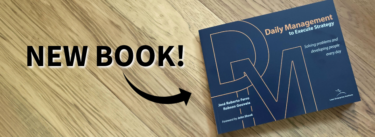Dear Gemba Coach,
I am a manufacturing engineer at a company in the process of lean transformation. We started by introducing single piece flow cell manufacturing at our shop levels which has had mixed results. On the positive side, we reduced our manufacturing lead times by more than half. This has increased our rate of quality rejections, however, and our top management is not convinced that we should keep on with this. To address the quality issues, we have introduced kaizen events. But operator morale has suffered terribly since we implemented cell manufacturing, and the ideas that kaizens generate have been weak. Would you please share your insights on this situation?
In order to answer let me take a step back. One of the key insights my father learned as a Toyota supplier was that he was looking at a full system, not a point-by-point improvement method. This wasn’t easy to see at first. The improvements that the Toyota engineers worked on the pilot line with my dad’s manufacturing engineers seemed point by point. They never explained much beyond “we solve problems as and when they appear.” At the time, the name of the game was definitely lead-time reduction (ah, that lake-and-the-rocks graph!) and the goal was to achieve one-piece-flow as soon as possible.
It took a great deal of time, and help from his Toyota sensei for my father to understand how everything fit together: as he reduced lead-time, many other problems were revealed: quality first, certainly, then component supply issues, machine stability and operator morale. In a way, what you’re describing is not surprising, and that truly is good news. The hard part is that in order to crack this you need to start thinking of lean as a system, as Freddy and I tried to describe in our novels The Gold Mine and The Lean Manager.
I believe that it’s likely your quality issues, operator morale and disappointing suggestions are all facets of the same issue: not thinking of operators first. Look at it this way: what is the most de-motivating for an operator? Operators come to work to make good parts and stay out of trouble. They hate being blamed for problems they feel are not their fault. This is a real concern. We don’t want them to be unhappy at work. The key to our customers’ satisfaction is in fact our employee’s satisfaction.
Your company’s lean transformation efforts have in all likelihood caused—or revealed—existing problems. When you made the changes to get to one piece flow, you probably took away each person’s personal safety stock of a few parts. This made all the problems each operator faces all day long visible. It shone a light on the quality problems by preventing workarounds; operators can no longer just bin the part and take the next one from the heap. Because of one piece flow, there is no heap. As a result, if you haven’t been extra careful about supporting operators through the change, chances are you’ve put them in a rough spot. And if their supervisor doesn’t get it, she can put pressure on operators without realizing it, just by reacting to the sheer number of issues that come up.
One Piece Flow Discipline
Twenty years after these early “model” lines, we have now accepted the truth that kaizen can’t happen without standards. This is particularly true for operators who need to be able to move confidently from one task to the next in order to feel they’ve had a successful day. This means that they need to be confident in their ability to distinguish OK work from not-OK work in order to feel sure they’ll not be caught out. This works only when supervisors allow (require) operators to signal problems as they crop up – the basis of the “jidoka” pillar, the twin brother of just-in-time in the lean system.
In many companies I know, there are no limits to the number of ideas about how to make parts—the problem is that few of these take into account how to do so in a way that makes much sense for operators.
To keep the overall system healthy, you need to launch an on-the-job development program in parallel with your lead-time improvement effort. This work will enable operators to capture the standards required to hold to the discipline of one piece flow. This is never simple to start from scratch, but the simplest way I’ve found is to ask the supervisor to set aside 20 minutes for operator training each day. We put up a large plan on the wall, where all operators can see their “training” day in the next couple of weeks. The supervisor has to be helped with understanding the one-to-one approach of one day, one person, next day, next person.
These training sessions will happen on the person’s own work station, during work at first – we will create a special environment to train critical tasks later. But on normal work, the first priority is to clarify:
- Job targets in terms of quality and quantity, highlighting in particular customer expectations for the part.
- The breakdown of the job in work elements, and their proper sequence – each work element should correspond to one OK vs. NOK decision. Two decisions means the element is too long, no decision means you’ve gone too far in breaking down the process.
- The necessary conditions to do the job right (cleanliness of the workspace, calibration of tools and gauges, correct information and data to do the job right, etc.). In particular the means to check whether components are OK or not.
- Clear judgment criteria. In fact, the whole aim of the 20 minutes is for the supervisor to clarify with the worker the judgment criteria on each job element. Work element completion should fit with the overall task targets as well as show “one element, one decision.”
- The supervisor’s job is then to document the upshot of the conversations she’ll be having with each operator and to learn to create the most intuitive “standards” sheets, as well as make them live as discussions progress with the employees.
Your job is to monitor the implementation of this on-the-job training program and keep in mind that any change in the work environment is likely to affect one or several work elements. Your task then is to develop and progressively enrich your own checklist to make sure the training occurs as it should. And, in particular, that judgment criteria are constantly refined. This is essential for manufacturing engineering because you and your team will start discovering practical manufacturing issues you’d never have dreamt up in a million years. In helping operators be more comfortable with their work, you’ll be learning many things about your own work.
Quality Suggestions
Furthermore, as “training” sessions continue and operators – particularly the experienced ones – start understanding what, exactly, you’re after and how the process really works, with its real-life constraints and problems, you’ll see that the quality of suggestions will improve dramatically. To understand the operator’s world you need to step back from the machine and see that their expertise field is movement – foot movement, hand movement, eye movement. As you study this with them, you will start radically rethinking equipment to sustain lead-time and productivity gains. The three elements of lead-time reduction, quality-improvement and standardization work hand in hand.
To conclude, your kaizen program (which is mostly, I assume, a workshop based program and, as such, collective) needs to be complemented with an individual development program. And to be honest, both of them need to be sustained by a gemba “go and see” program where senior management visits the lines to see progress, hear difficulties and learn about work’s real value-adding or non value adding conditions (which would also help with your management involvement issues). To a large extent, I could summarize the lean programs we set up in companies as:
- A “go and see” gemba visit program for senior management
- A “dojo” style one-to-one training program for operators supported by the management line
- A kaizen workshop program to crack lead-time issues (such as flow and layout, SMED), deep quality issues (quality in-depth analysis) or equipment stability issues (TPM)
With a pull system threading these three programs together, you can move from point kaizen to implement a full lean system in your shop.
Don’t feel too bad – this is a common mishap. If there is one thing to learn from your adventure, it is to keep in mind the wisdom of the lean tradition: motion kaizen first, then equipment kaizen and finally process kaizen. Our re-engineering habits tends to move machines around for quick gains first, but the true lean breakthrough is to put customers first by first focusing on the operators’ perspective and mission in any changes you’re considering. Great people make great parts – as well as processes.






